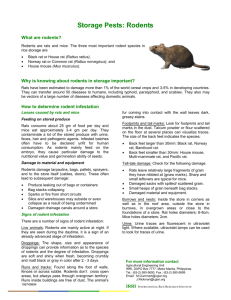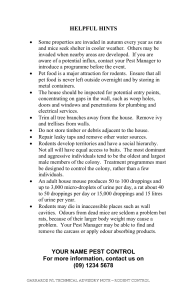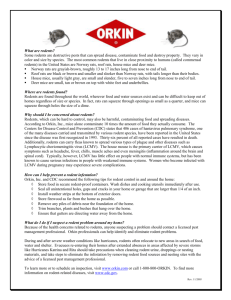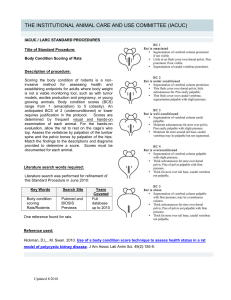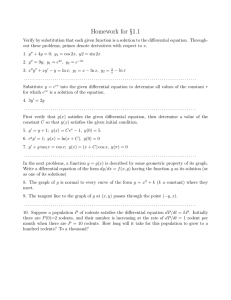Getting Rid of Rodents (Rats and Mice)
advertisement
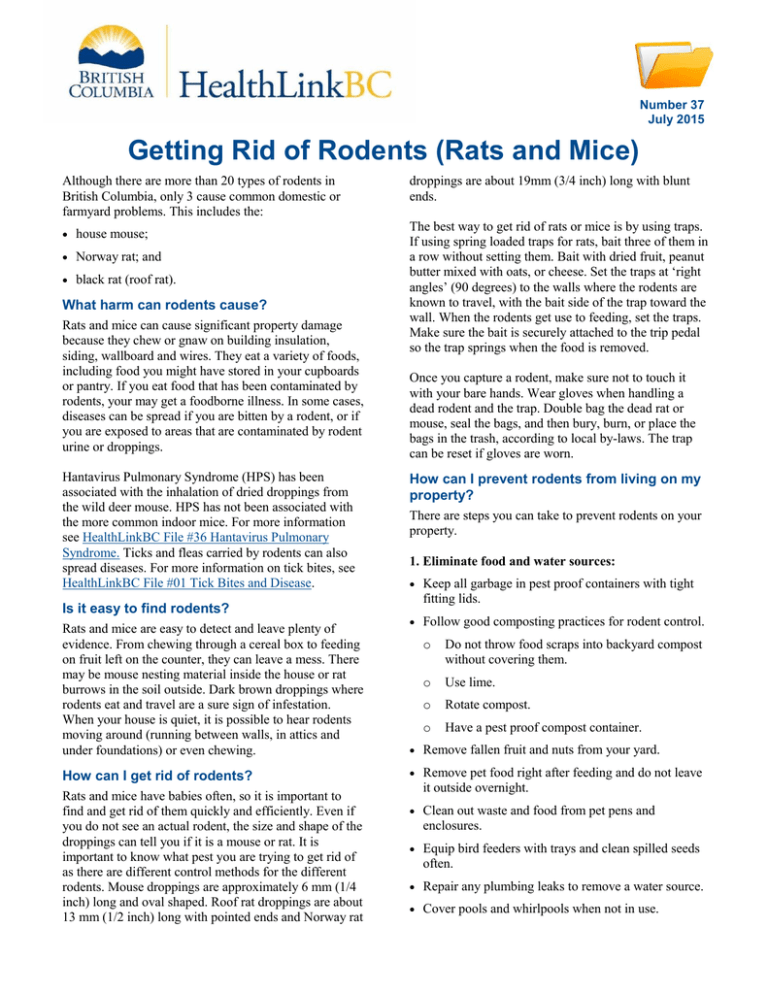
Number 37 July 2015 Getting Rid of Rodents (Rats and Mice) Although there are more than 20 types of rodents in British Columbia, only 3 cause common domestic or farmyard problems. This includes the: house mouse; Norway rat; and black rat (roof rat). What harm can rodents cause? Rats and mice can cause significant property damage because they chew or gnaw on building insulation, siding, wallboard and wires. They eat a variety of foods, including food you might have stored in your cupboards or pantry. If you eat food that has been contaminated by rodents, your may get a foodborne illness. In some cases, diseases can be spread if you are bitten by a rodent, or if you are exposed to areas that are contaminated by rodent urine or droppings. Hantavirus Pulmonary Syndrome (HPS) has been associated with the inhalation of dried droppings from the wild deer mouse. HPS has not been associated with the more common indoor mice. For more information see HealthLinkBC File #36 Hantavirus Pulmonary Syndrome. Ticks and fleas carried by rodents can also spread diseases. For more information on tick bites, see HealthLinkBC File #01 Tick Bites and Disease. Is it easy to find rodents? Rats and mice are easy to detect and leave plenty of evidence. From chewing through a cereal box to feeding on fruit left on the counter, they can leave a mess. There may be mouse nesting material inside the house or rat burrows in the soil outside. Dark brown droppings where rodents eat and travel are a sure sign of infestation. When your house is quiet, it is possible to hear rodents moving around (running between walls, in attics and under foundations) or even chewing. How can I get rid of rodents? Rats and mice have babies often, so it is important to find and get rid of them quickly and efficiently. Even if you do not see an actual rodent, the size and shape of the droppings can tell you if it is a mouse or rat. It is important to know what pest you are trying to get rid of as there are different control methods for the different rodents. Mouse droppings are approximately 6 mm (1/4 inch) long and oval shaped. Roof rat droppings are about 13 mm (1/2 inch) long with pointed ends and Norway rat droppings are about 19mm (3/4 inch) long with blunt ends. The best way to get rid of rats or mice is by using traps. If using spring loaded traps for rats, bait three of them in a row without setting them. Bait with dried fruit, peanut butter mixed with oats, or cheese. Set the traps at ‘right angles’ (90 degrees) to the walls where the rodents are known to travel, with the bait side of the trap toward the wall. When the rodents get use to feeding, set the traps. Make sure the bait is securely attached to the trip pedal so the trap springs when the food is removed. Once you capture a rodent, make sure not to touch it with your bare hands. Wear gloves when handling a dead rodent and the trap. Double bag the dead rat or mouse, seal the bags, and then bury, burn, or place the bags in the trash, according to local by-laws. The trap can be reset if gloves are worn. How can I prevent rodents from living on my property? There are steps you can take to prevent rodents on your property. 1. Eliminate food and water sources: Keep all garbage in pest proof containers with tight fitting lids. Follow good composting practices for rodent control. o Do not throw food scraps into backyard compost without covering them. o Use lime. o Rotate compost. o Have a pest proof compost container. Remove fallen fruit and nuts from your yard. Remove pet food right after feeding and do not leave it outside overnight. Clean out waste and food from pet pens and enclosures. Equip bird feeders with trays and clean spilled seeds often. Repair any plumbing leaks to remove a water source. Cover pools and whirlpools when not in use. 2. Eliminate hiding and living places: Keep building perimeters clear of plantings, stored lumber or junk. Trim plants near buildings so that 15 to 20 cm (6 to 8 inches) above ground is clear. Trim branches of trees or shrubs to prevent access to roofs or balconies. Remove unused piles of lumber and old sheds. Do not store old cars or furniture outside. Store lumber and firewood on stands 30 cm to 45 cm (12 to 18 inches) off the ground. 3. Pest proof buildings: enclosed area for 30 minutes and wetting down the area with household disinfectant before you start. Most general purpose disinfectants and household detergents are effective. A mixture of 1 part bleach and 10 parts water can also be used. Pour mixture carefully onto the area to avoid disturbing any virus present - do not use a sprayer. Wipe up droppings, nesting materials and other waste with a paper towel and place in a plastic garbage bag. Do not sweep or vacuum. Double bag the contents, seal the bags, and then bury, burn, or place the bags in the trash, according to local by-laws. Cover crawl spaces, fresh air and attic vents with 6mm (1/4 inch) metal screening or steel mesh. Seal any possible entry points in the building exterior that are greater than 6mm (1/4 inch). Pay close attention to door jams and gaps between the siding and the house foundation. If you have roof rats don’t forget to check for holes in areas of the roof. Clean floors, carpets, clothing and bedding, and disinfect counter-tops, cabinets and drawers that have been in contact with mice. Wash rubber gloves with disinfectant or soap and water before removing them. Wash your hands with soap and water after removing gloves. Repair cracks in cement footings and foundations. Build sheds on concrete slabs. Can I use poison to get rid of rodents? It is not a good idea to use poison or baits to control rodents. Poisoned rodents can crawl away and die, and their bodies can be hard to find and result in unpleasant odors. Poisons can also accidentally harm pets, wild animals, or even children. Ultrasound repellers, although effective at first, are expensive and do not have long-term success at eliminating rodents. If after taking preventive measures, a rat problem still exists on your property and you want to try rat poison, there are certain things you should consider: Set out non-poisoned food for a few days prior to baiting, so the rodent starts feeding in the area. Read and follow the directions on the label carefully. Set bait in areas where there is no access to children or pets. Remove dead rodents promptly and remove all bait During clean-up, make sure to wear an appropriate, wellfitting filter mask, rubber gloves and goggles. For more information on appropriate masks contact your local public health unit or environmental health officer. For More Information For more information, visit Government of British Columbia – Rodents at www2.gov.bc.ca/gov/content/environment/pesticidespest-management/managing-pests/animals/rodents, or contact your local environmental health officer. For more HealthLinkBC File topics, visit www.HealthLinkBC.ca/healthfiles or your local public health unit. Click on www.HealthLinkBC.ca or call 8-1-1 for non-emergency health information and services in B.C. For deaf and hearing-impaired assistance, call 7-1-1 in B.C. stations once pest control has been completed. If you are unable to control rodents on your own, contact a licensed company with certified staff to help you. How can I clean up areas where rodents have been? Prevent stirring up dust when you are cleaning areas where mice have lived. This includes ventilating any Translation services are available in more than 130 languages on request.
